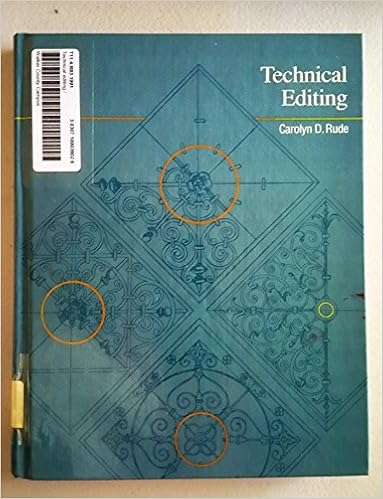Technical Editing Fifth Edition Rude Dog
Rude is the author of 'Technical Editing (5th Edition) (The Allyn & Bacon Seriesin Technical Communication)', published 2010 under ISBN 718 and ISBN. Technical Editing, 5th edition, Rude & Eaton Materials distributed via email A quality dictionary A writing handbook Course Description Advanced practice and theory in professional editing, including copyediting and comprehensive editing. Focus on working effectively with writers, publishers, and audiences. Discussion of the. Technical Editing Fifth Edition Rude. Your save games are stored in the cloud — for free on Xbox Live and Steam, but only for PlayStation Plus subscribers on PS4 — so you can pick right up where you left off.
Technical Editing Fifth Edition Rude Dog Show


London in many places shows Johnson's technical. For over a year he was involved in editing and. The Yale Edition of the Works of Samuel Johnson.

The Comma Johanneum, also called the Johannine Comma or the Heavenly Witnesses, is a (a short clause) found in of the. The comma first appeared in the manuscripts of the 9th century. [ – ] The first manuscript that contains the comma dates from the 15th century. The comma is absent from the, and translations of the Greek New Testament.
Technical Editing Fifth Edition Rude Dog And Friends
The scholarly consensus is that that passage is a corruption that entered the manuscript tradition in some subsequent copies. As the comma does not appear in the manuscript tradition of other languages, the debate is mainly limited to the due to the. — John Scott Porter writes: Augustine, in his book against Maximin the Arian, turns every stone to find arguments from the Scriptures to prove that tho Spirit is God, and that the Three Persons are the same in substance, but does not adduce this text; nay, clearly shows that he knew nothing of it, for he repeatedly employs the 8th verse, and says, that by the Spirit, the Blood, and the Water—the persons of the Father, Son, and Holy Spirit, arc signified (see Contr. Thomas Joseph Lamy offers a different view based on the context and Augustine's purpose. Similarly Thomas Burgess. And Norbert Fickermann's reference and scholarship supports the idea that Augustine may have deliberately bypassed a direct quote of the heavenly witnesses. Leo the Great [ ] In the, written to, read at the on 10 October 451 AD, and published in Greek, 's usage of 1 John 5 has him moving in discourse from verse 6 to verse 8: This is the victory which overcometh the world, even our faith'; and: 'Who is he that overcometh the world, but he that believeth that Jesus is the Son of God?
This is he that came by water and blood, even Jesus Christ; not by water only, but by water and blood; and it is the Spirit that beareth witness, because the Spirit is truth. Download Jah Wobble Edge The Holger Czukay Snake Charmer Rarity on this page. For there are three that bear witness, the spirit, the water, and the blood; and the three are one.' That is, the Spirit of sanctification, and the blood of redemption, and the water of baptism; which three things are one, and remain undivided. This epistle from Leo was considered by to be the 'strongest proof' of verse inauthenticity ('the strongest proof that this verse is spurious may be drawn from the Epistle of Leo the Great to Flavianus upon the Incarnation' ) and went along with Porson's assertion that the verse was slow to enter into the Latin lines.
Porson asserted that the verse 'remained a rude, unformed mass, and was not completely licked into shape till the end of the tenth century'. In response, Thomas Burgess points out that the context of Leo's argument would not call for the 7th verse. And that the verse was referenced in a fully formed manner centuries earlier than Porson's claim, at the time of Fulgentius and the Council of Carthage. Burgess pointed out that there were multiple confirmations that the verse was in the Latin Bibles of Leo's day. Burgess argued, ironically, that the fact that Leo could move from verse 6 to 8 for argument context is, in the bigger picture, favorable to authenticity. 'Leo's omission of the Verse is not only counterbalanced by its actual existence in contemporary copies, but the passage of his Letter is, in some material respects, favourable to the authenticity of the Verse, by its contradiction to some assertions confidently urged against the Verse by its opponents, and essential to their theory against it.' Today, with the discovery of additional Old Latin evidences in the 19th century, the discourse of Leo is rarely referenced as a significant evidence against verse authenticity.
Technical Editing Fifth Edition Rude Dog And Cat
Early Church Writer evidence [ ] Cyprian of Carthage [ ] Unity of the Church [ ] The 3rd-century Church father Cyprian (c. 200–58), in writing on the Unity of the Church, Treatise I section 6 quoted John 10:30 and another scriptural spot. The Lord says, 'I and the Father are one' and again it is written of the Father, and of the Son, and of the Holy Spirit, 'And these three are one.' The Catholic Encyclopedia concludes 'Cyprian. Seems undoubtedly to have had it in mind'. Against this view, writes that since Cyprian does not quote the Father, the Word, and the Holy Spirit 'this in the least does not afford proof that he knew of such wording'.